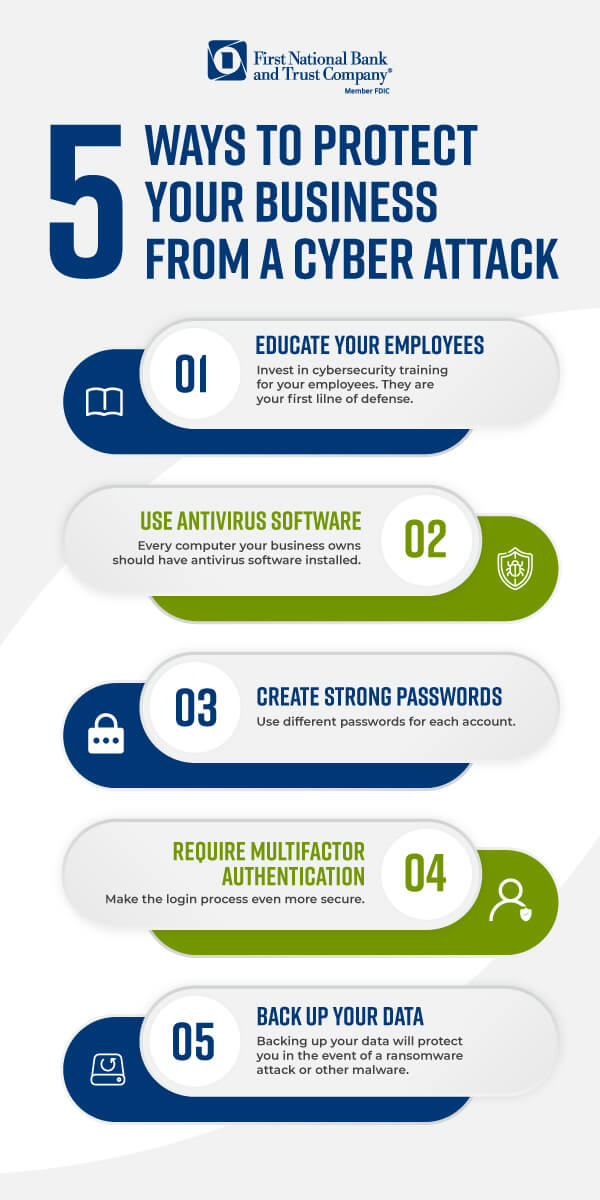Top 5 Ways to Protect Your Business from Cybersecurity Threats
Cyberattacks cost American businesses and individuals billions of dollars in financial losses each year. In this blog, we’ll help you understand the cybersecurity threats you face and show you how to protect your business, employees, and customers from cyberattacks.

Unfortunately, the number of reported incidents and the total amount lost has been increasing year over year. And money is not the only thing your business stands to lose from cybersecurity threats. As a small business owner, your
personal credit score could be impacted. Your company’s reputation could take a hit, especially if your
customer data is breached and exposed.
Top Business Cybersecurity Threats to Know About
Before you can learn how to prevent cyberattacks, you need to know what to look out for.
1. Malware
Stands for “malicious software,” which is a type of attack on your computer to steal data or exact a ransom. Specific types of malware include:
- Trojan Horse: Malware is hidden in something you download such as an app, file, or program.
- Worm: Infects your operating system and the programs on your computer.
- Virus: Designed to harm your computers, network, and other devices. Spreads easily from one computer to another.
- Ransomware: Blocks access to your computer or specific files and data until the ransom amount is paid.
- Spyware: Allows the cybercriminal to view your computer activities and the information stored on your machine by secretly transmitting data from your hard drive.
Ransomware frequently targets small businesses through email spam and network attacks. Falling victim to a ransomware attack can be disastrous for a business. First of all, there is no guarantee that the thieves will actually return your data after you pay them. There is usually a short window (24-48 hours) in which to pay. And you may also have to pay for an investigation into what happened and how, not to mention notifying your customers if their personal information was stolen.
2. Phishing
Gains your trust by posing as a legitimate person or entity through email, text messages, and social media messages. The purpose of phishing attacks is usually to steal personal data and login credentials. When targeting businesses, phishing messages may appear to be a legitimate invoice or payment portal link. However, once you download the attached “invoice” or click on the link, you may unknowingly download malware onto your computer or sharing login credentials and other sensitive information.
Specific types of phishing include:
- Spear phishing: Targets a specific person within the business and uses personal details such as name, job title, and other information to be more convincing.
- Whaling: Targets senior executives by imitating a busy CEO who needs a quick favor such as a wire transfer.
- Smishing and vishing: Refers to text messages and voice calls. A common smishing scam is to imitate your bank with a fraud alert prompting you to log in over a malicious link.
- Angler phishing: Uses social media posts and direct messages to trick you into sharing personal details or login credentials.
- Pharming: The use of malicious code to create spoofed websites where you may unwittingly share your credentials and sensitive information, thinking the website is legitimate.
3. Password Hacking
High-speed computer programs can quickly guess and test passwords for cybercriminals. If you and your employees use the same password for every account, use personal information to create passwords, or have a common password such as “password” or “abc123,” your business will be more vulnerable to password theft.
4. Denial-of-Service (DoS)
When hackers flood your business website with traffic or send certain information that triggers a crash. The purpose is to shut down the targeted website or network so it cannot be used.
5. Internet of Things (IoT) Attack
An attack on a business’s devices, networks, data, or users. The purpose is usually to steal sensitive information and data.
Read more about the
Top Cybersecurity Threats To Avoid.

How to Prevent a Cyber Attack on Your Business
Now that you understand what you’re dealing with, learn how to protect your business from cybersecurity threats.
Educate Your Employees
Your employees are one of the first lines of defense in your cybersecurity strategy, but they can also be a weak link. Invest in cybersecurity training for your employees during the onboarding process and then at least once a year thereafter.
Use Antivirus Software
Every computer your business owns should have antivirus software installed on it. Don’t ignore patches and updates–you can set them up to install automatically. Otherwise, you’re leaving yourself open to security vulnerabilities.
Create Strong Passwords
Use different passwords for each account. Password managers can help you generate and keep track of strong passwords for all your logins. When creating passwords, follow these characteristics:
- 10+ characters
- Uppercase letter(s)
- Lowercase letter(s)
- Number(s)
- Special character(s)
Alternatively, consider using a passphrase instead of a password. A passphrase should be easy for you to remember, though not easy to guess. It can be a sentence or phrase made up of four to ten words. And you can still incorporate the characteristics of strong passwords listed above.
Require Multifactor Authentication
Have you ever been prompted to enter a one-time security code sent to your phone or email after entering login credentials? That is multifactor authentication. Turning on this option wherever possible will make it harder for hackers to breach your accounts, even if they can guess your password.
Regularly Back up Your Data
Backing up the data on your business computers will protect you in the event of a ransomware attack or other malware. While you may not be able to prevent ransomware attacks all of the time, you won’t be in as much trouble if you have another copy of your data somewhere. Set up regular automatic backups if possible, such as once a week.
Additional Cybersecurity Resources
For more cybersecurity tips, check out First National Bank and Trust’s blog on “
Holiday Season Cybersecurity Tips For Small Businesses.” as well as our video resources and
Security Tips for Businesses. We also offer
Fraud Management Solutions and other business services to help you run your business safely. Still have questions?
Contact our Business Banking Team.